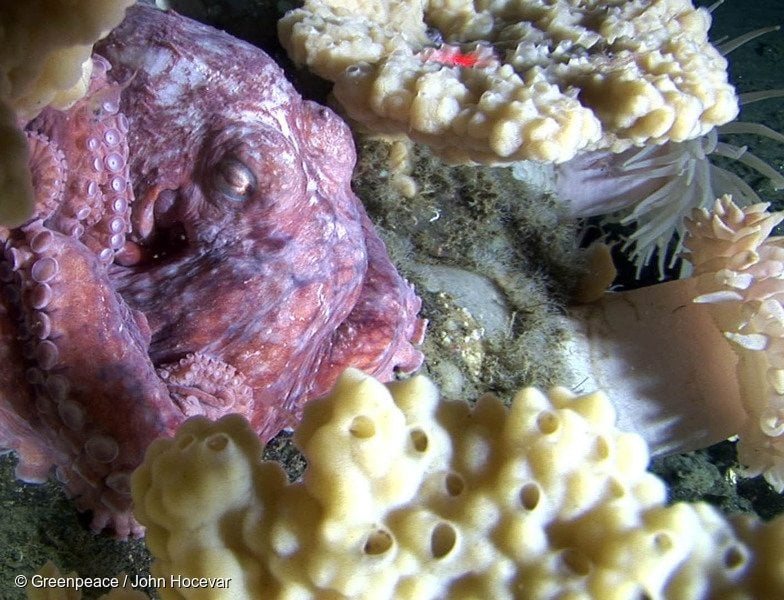Ask any scuba diver and they’ll tell you: find the coral and sponges and you’ll find the fish. Bird watchers, similarly, head for the trees and wetlands to spy winged biodiversity.
Find the habitat, find the wildlife.
We would never allow any industry to bulldoze through Yellowstone Park, destroying homes for bears, wolves, moose, and bison. In the ocean, though, it’s a different story. This is the last place on Earth where wild animals are commercially hunted, and oil, gas and mineral companies have their sights on the profits that come from mining seafloor riches, not so much on protecting our future.
But just weeks ago, good news came for those marine animals, their homes, and the people who rely on them.
Something Big Just Happened
In a big step forward for ocean conservation, U.S. fishery managers have elected to protect deep-sea corals and sponges and the underwater canyons where they thrive off the Atlantic coast.
The Mid-Atlantic Fishery Management Council—one of eight regional bodies tasked with managing and conserving our ocean resources—voted to prohibit all bottom-contact fishing (with one exception for the small red crab trap fishery) below 450 meters in 38,000 square miles of ocean, an area the size of Maryland.
This isn’t just great news for the corals and sponges on the seafloor, it’s great news for everyone in the neighborhood. Unlike their tropical cousins, deep-sea corals and sponges thrive far below the sun’s penetrating rays. They provide what amounts to the only hotel in town for fish, crab and other marine life in an otherwise often featureless environment. Over time, these long-lived, extremely slow growing animals create foraging, spawning and nursery areas, plus cover from predators and strong currents.
How Commercial Fishing Threatens Ocean Ecosystems
Commercial fishing today involves massive trawl nets, both bottom and mid-water trawls that drag across the seafloor as crews target fish that live on or near the bottom of the ocean. While this is an efficient way to catch billions of pounds of fish quickly, it comes with a huge price to any living organisms in the path of such mega fishing gear. Encounters with immense trawl nets and other heavy fishing gear can destroy valuable corals and sponges in an instant, and there goes the neighborhood.
Very little is currently understood about the full value of this habitat for marine life and ecosystems, but there is widespread international agreement that it should be protected from destructive human activities such as commercial fishing. The U.S. government, for instance, has a Strategic Plan for Deep Sea Coral and Sponge Ecosystems. Its top conservation and management objective is to “protect areas containing known deep-sea coral and sponge communities from impacts of bottom-tending fishing gear.”
Even with such clear priorities in place since 2010, habitat protections have been slow to come. Pulling 10 billion pounds of fish from the ocean each year, worth more than $5 billion dollars, is the first objective for our nation’s fishery managers.
The Atlantic coast decision, more than three years in the making, was not without contention, collaboration and compromise. The Mid-Atlantic Council planned on taking final action in February, but strong opposition from the fishing industry caused a delay until June. Workshops were held, and hundreds of thousands of public comments were submitted. Ultimately, stakeholders including fishing and conservation representatives reached agreement on 15 discrete canyon areas to protect and a broad no-go zone for bottom contact gear, which the Council largely sanctioned.
With this historic decision, the Mid-Atlantic Council has raised the bar for other regions. It is now the first Council to use new policy guidance introduced in the 2007 reauthorization of the Magnuson-Stevens Act which gives Councils discretionary authority to protect coral and sponge habitat from fishing.
It’s Time to Take the Next Step: Protect the Bering Sea
In Alaska’s Bering Sea, the world’s largest undersea canyons have been the focus of repeated proposals for protection since 2002. Government research now verifies earlier government models predicting the locations of coral and sponge habitat. Pribilof Canyon—larger than the Grand Canyon but composing only 10 percent of the study area—is confirmed to house half of the coral in the Bering Sea. A new publication from independent scientists similarly finds Pribilof Canyon to be a hot spot for Bering Sea coral and sponges. The new science jointly confirms the unique nature of the Bering Sea slope and canyons, the plankton-rich zone known as the Green Belt.
Nearly all high value coral habitat in the Bering Sea is found here, yet none of it is protected.
The North Pacific Fishery Management Council will decide on next steps for Bering Sea corals at its next meeting. Will Alaska’s fishery managers rise to the task and protect these coral and sponge neighborhoods for commercially valuable rockfish, king crab and other species? We’ll be there joining the voices of hundreds of thousands of people, tribal and environmental groups, and many of our nations largest supermarkets and seafood buyers calling on them to protect neighborhoods in the North Pacific, too.
Lend your voice to the call to protect the Bering Sea today.



